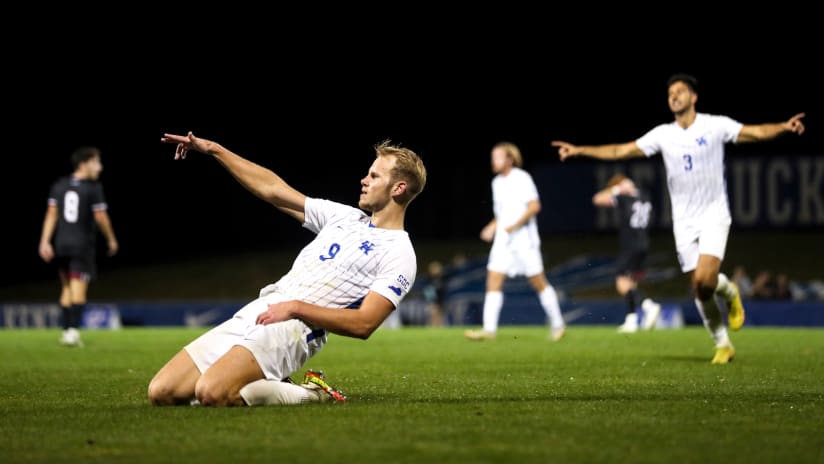If there’s any image that endures from Sounders FC’s 2015 MLS SuperDraft, it’s that of Garth Lagerwey weaving through draft tables and quietly but passionately entreating with fellow general managers over a frantic period of about a half hour.
Lagerwey had only been in Sounders Rave Green for a month when he flew to Philadelphia with the team for the draft. If Seattle brass didn’t entirely know what it was getting with Lagerwey before, the general manager’s flurry of motion that afternoon cemented his status as Seattle’s Wheeler-Dealer-In-Chief.
The Sounders had their eye on local product Cristian Roldan before the draft, and as the first round progressed, the Generation adidas midfielder kept dropping. First out of the top five, then out of the top 10, and then further. The Sounders didn’t have a first round pick, but the more Roldan dropped, the more the Sounders’ war room conferred.
This kid might be worth trading up for.
As he’d been doing throughout the first round, Lagerwey made his way to one table after another in search of a deal, a crack through which to enter the first round. He finally found one through former club Real Salt Lake, which willingly parted with its No. 16 overall pick to allow Seattle to creep into the back end of the first round. Right then the Sounders knew they had their man, both in Roldan and Lagerwey.
“He was very influential in getting that trade done for Roldan,” Sounders coach Sigi Schmid told Soundersfc.com last week. “That was very helpful, because he had the connection there (with RSL) that allowed that to happen.”
Roldan was a vital rotation option in the midfield for Schmid this year, proving Seattle had done its homework and backed that up with due diligence on draft day.
That process is about to begin anew.
Seattle charges into Thursday’s draft in Baltimore in much of the same position. The Sounders pick 15th this year, a neighborhood that’s been notoriously fickle for MLS prospects. A 15th pick hasn’t developed into a regular starter in the league since Columbus Crew SC’s Justin Meram, who was taken in 2011. There are talented prospects out there, but whether they’ll still be on the board - and whether they’ll fit into Schmid’s favored 4-4-2 - is another matter.
As far as Schmid is concerned, strengthening and getting younger through the central midfield and outside back positions will be paramount in this draft, as too will be adding youth at center back. Oniel Fisher played both fullback positions last year, and Leo Gonzalez’s departure likely means Fisher and Dylan Remick will compete for the left back slot.
If Tyrone Mears holds down the right side while some combination of Brad Evans, Chad Marshall and Román Torres cycles through the middle, they’ll still need depth.
The central midfield should be a place of concentration as well. The retirement of Gonzalo Pineda and departure of Micheal Azira to Colorado leaves positions up for grabs. With Scotiabank CONCACAF Champions League play looming, Seattle will likely need more than just Osvaldo Alonso, Erik Friberg and Roldan rotating through on a regular basis.
“We certainly have areas we know we have a little bit of a need in, or that an area maybe where we have an older player and we want to find a young player and let him develop for a year or so,” Schmid said. “On the same token, you’re looking for best players. Sometimes you’re going into the draft, and maybe you have a little bit of a need, but maybe a guy pops up on your radar, and you sit there and go, ‘Man, this guy is too good to pass up.’"
In conferring with his draft scouting experts, one of which is his son Kurt, Schmid noted they don’t think this draft is as deep as those in the past, and the option of trading out of the first round for allocation money or a player at a position of need isn’t out of the question.
That’s not to say they will, but the front office’s history of due diligence in the scouting department gives them some leeway. Seattle established itself as a reliable picker in the late rounds, with Fisher (No. 40), Andy Craven (No. 48), and Charlie Lyon (No. 75) all establishing themselves as promising players following last year’s draft. If Seattle doesn’t pick in the first round in Baltimore, they’re confident in finding possible gems with picks in the second, third and fourth rounds.
That said, Schmid said the scouting department has its eyes on a few prospects in particular, though he declined to mention particular names. The mere fact, though, that Seattle’s end-of-season position always leaves them outside the top 10 means they’ve gotten adept at being resourceful come draft time.
As for trading up, could that be a possibility? Don’t rule anything out.
“When you’re trading up, you’ve usually got to throw something in that’s usually money,” Schmid said. “Money is a high priority for us right now, so that’s not necessarily something we want to trade away. Last year we felt like we had a little bit of money, but obviously the cap didn’t increase as much as us and many other teams thought, so I think everybody’s tight this year on money, so you might see less trading up. But there might be situations where teams say, ‘You trade us that player for this pick,’ that puts us ahead of where we would be if it’s just money.”
Even if the Sounders’ 2016 draft isn’t quite as white-knuckle as it was last year, Schmid understands better than most that the excitement of the day is worth savoring.
“It’s the excitement of the unknown. What’s going to happen here?” Schmid said. “What’s this kid going to do? How’s he going to fit in? Is this going to be the guy who makes his way? If you throw him into the deep end of the pool, is he going to be a guy who finds his way to swim to the other side? That’s what you’re looking for all the time, and there’s an excitement level to that.”





